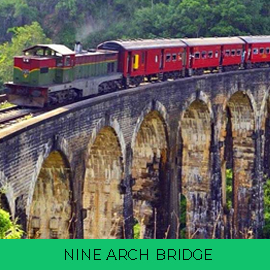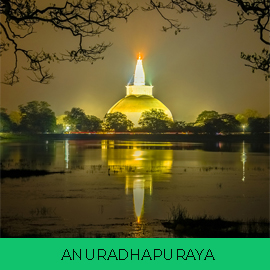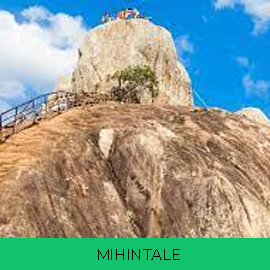Popular Tours
- Home
- .
- Destinations

Checkout Beautiful Places Arround the
Sri Lanka
Pinnawala Elephant Orphanage

Currently being a home to 93 elephants and started on the 16th of February 1975. Pinnawala at the time was a very remote area with lush coconut plantations and Also the immense amount of water required by the elephants is important with the availability of “Ma oya”. House of the abandoned and the wounded elephants, the orphanage has grown to be a big family today. The number of elephants has increased to more than 90 now, including baby elephant brought from various parts, as well as 50 babies borned as a result of the captive breeding program. 1984, the first baby elephant of Pinnawala was born. The best time to visit is the feeding time and the bathing time when the elephant are taken to the river close by. A unique experience never to be missed.
Afternoon city tour of Kandy, including Upper Lake Drive, Market Square, Arts & Crafts Centre, Gem Museum and Temple of the Sacred Tooth Relic.
Kandy

The hill capital, venue of the annual Perahera and a major city in Sri Lanka located in the Central Province. It was the last capital of the ancient kings' era of Sri Lanka and finally ceded to the British in 1815. The city lies in the midst of hills in the Kandy plateau, which crosses an area of tropical plantations, mainly tea. Kandy is both an administrative and religious city and is also the capital of the Central Province. Kandy is the home of the Temple of the Tooth Relic (Sri Dalada Maligawa), one of the most sacred places of worship in the Buddhist world. Kandy is revered by Buddhists as a sacred city because of the (Dalada Maligawa) Temple of the Sacred Tooth Relic of Lord Buddha. Temples shrines and monasteries keeping alive Buddhist traditions are everywhere. It was declared a world heritage site by UNESCO in 1988. Historically the local Buddhist rulers resisted Portuguese, Dutch, and British colonial expansion and occupation.
Kandy is the venue of the annual glittering pageant each August where the Buddha’s Tooth Relic in a golden casket is paraded on a majestic elephant accompanied by over 100 elephants, fire dancers, and ceremonial whip crackers, dancers and drummers.
Temple of the Sacred Tooth Relic - (Sri Dalada Maligawa)

Temple of the Sacred Tooth Relic - (Sri Dalada Maligawa) - Commonly known as the Glorious Tooth Temple, is a Buddhist temple in Kandy, Sri Lanka. It is located in the royal palace complex of the former Kingdom of Kandy, which houses the relic of the tooth of the Buddha. Since ancient times, the relic has played an important role in local politics because it is believed that whoever holds the relic holds the governance of the country. The relic was historically held by Sinhalese kings. The temple of the tooth is a World Heritage Site mainly due to the temple and the relic.
Ever since 4th Century A.D, when the Buddha’s Tooth was brought to Sri Lanka hidden from sacrilegious hands in an ‘Orissan princess’ hair, the Relic has grown in reputations and holiness in Sri Lanka and throughout the Buddhist world. It is considered Sri Lanka’s most prized possession. Bhikkhus of the two particular chapters, the Malwathu chapters and Asgiri chapters, conduct daily worship in the inner chamber of the temple. Rituals are performed three times daily: at dawn, at noon and in the evenings. On Wednesdays, there is a symbolic bathing of the relic with a herbal preparation made from scented water and fragrant flowers called Nanumura Mangallaya; this holy water is believed to contain healing powers and is distributed to those present.
Bhikkhus of the two particular chapters, the Malwathu chapters and Asgiri chapters, conduct daily worship in the inner chamber of the temple. Rituals are performed three times daily: at dawn, at noon and in the evenings. On Wednesdays, there is a symbolic bathing of the relic with a herbal preparation made from scented water and fragrant flowers called Nanumura Mangallaya; this holy water is believed to contain healing powers and is distributed to those present.
Spice & Herbal Garden

Royal Botanical Garden in Peradeniya is 06 kms from Kandy, the magnificent 57 hectares laid out in 1832. is among the finest in the world. Its treasures of tropical flora include fine collections of orchids, aromatic spices, medicinal herbs, palms and rare endangered plant species. These gardens were the naturally camouflaged operations headquarters of SEAC Supreme Allied Commander, Lord Louis Mountbatten during the 2nd World War.
Spice & Herbal Garden

Enjoy the Sri Lanka’s world-renowned spices at their source. Visit a spice garden, where smells of cinnamons, pepper, cardamom, nutmeg and mace invade the senses. The visitors are provided an insight into a glimpse of a centuries-old spice production industry, which attracted many a European and Asian merchant to the ports of ancient Sri Lanka.
Ramboda Waterfall

Ramboda Waterfall – unique and beautiful view can be seen in the Pussellawa area of Nuwara Eliya, at Ramboda Pass. The Ramboda Falls (Height:109 m) in Sri Lanka a tributary of the Kothmale Oya. It forms a twin with the Dunsinane Falls, created by Pundalu Oya, also a tributary of the Kothmale River.
Tea Plantation & Factory

Tea Plantation & Factory – Proceed to a tea plantation and factory in the mountains where you will have the unusual opportunity of joining tea pluckers in picking the signature ‘two leaves and a bud’ which are later processed as tea for export around the world.
This is a fine art and you will have the chance to learn it from the experts as they pluck these buds with precision and speed. after that visit the factory where old machines before the industrial revolution and see how do wither roll and dry tea. you will observe the process that transforms the raw green leaf in to the familiar brown particles of made tea. After experiencing tea production participate in a tea tasting session to sample some of the various grades of tea produced at the estate’s factory.
Nuwara Eliya

Nuwara Eliya – “The City of Light” was the favorite hill station of the British, a scenic town 2500 m above sea level surrounded by misty mountain ranges, pine forests and tea cultivations. Nuwara Eliya has a much cooler climate, which is in stark contrast to the tropical climate experienced in other parts of the island. This is probably why Nuwara Eliya is also known as ‘Little England’. Once you arrive in Nuwara Eliya take a city tour to explore the amazing sightseeing of this town. There climate too, adds to the illusion of one stepping into an old English town, where neat hedges, quaint cottages and beautiful old buildings stand as serene as they did well over a century ago and the magnificent Grand Hotel presiding over them all.
The areas around Nuwara Eliya also provide the main output of tea in Sri Lanka. A trip to the highlands of Sri Lanka is never complete without witnessing the age-old traditional tea plucking and sipping a cup of “Ceylon Tea”. Nuwara Eliya has a fair assortment of British Country style houses and an Golf Course, which is a real beauty with its scenic location considered to be one of the finest in Asia and a picturesque Race Course where horse races are held.
Horton Plains
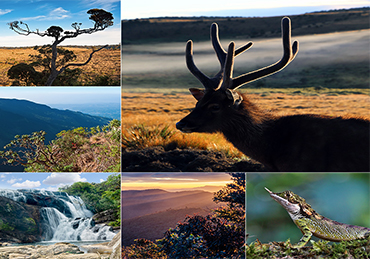
Horton plains - Horton Plains, Sri Lanka, is the coldest and windiest place in the country. Horton Plains, its surroundings, its forests and the nearby Peak Wilderness make up Sri Lanka’s largest water parting. almost all the great rivers. At the southern end of the Horton Plains, 2140 m above sea level, is the world-famous end. The most common wildlife sites on the Horton Plains are Sambar deer herds. Other mammals in the park include the white-throated mongoose, the long-tailed squirrel, the endemic monkey and the feline monkey.
Saint Clair Water Falls

Saint Clair falls – St. Clair’s Falls is one of the widest waterfalls in Sri Lanka and is commonly known as the “Little Niagara of Sri Lanka”. The falls are located along the Kotmale Oya, a tributary of the Mahaweli River, as it cascades over three rock outcrops into a large pool running through a tea estate, from which the falls derive their name from. The waterfalls consist of two falls called “Maha Ella” (Sinhalese “The Greater Fall”), which is 80 metres (260 ft) high and 50 metres (160 ft) wide and “Kuda Ella”, (Sinhalese “The Lesser Fall”), which is 50 metres (160 ft) high and located immediately downstream of the main fall. St Clair’s falls are the 20th highest waterfall in Sri Lanka.
Devon Water Falls

Devon Falls - known as the ‘Veil of the Valley’, is a waterfall in Sri Lanka, situated 6 km (3.7 mile) west of Talawakele, Nuwara Eliya District on the A7 highway. The falls is named after a pioneer English coffee planter called Devon, whose plantation was situated nearby the falls. The waterfall is 97 m (318 ft) high and is the 19th highest in the country. The falls are formed by a tributary of Kothmale Oya, which is a tributary of Mahaweli River. The elevation of Devon Falls is 1,140 m (3,740 ft) above sea level.
Dambulla Cave Temple/Golden Temple of Dambulla
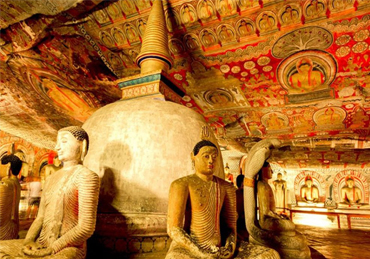
Dambulla, a major town in the Central Province of Sri Lanka, is a key junction and the center of vegetable distribution across the country. The town is widely visited for the largest & most well-preserved cave complex on the island.
Major Attractions of Dambulla.

The famous Dambulla Cave Temple also known as the Golden Temple of Dambulla is a destination not to be missed if you visit Sri Lanka. One of the iconic attractions in Sri Lanka, the exquisite rock temple of Dambulla dates back to the 1st century BC when the exiled King Valagam Bahu took refuge in the caves with the monks residing here, and later converted the caves into a beautiful temple complex.
The devotees climb barefoot up the slope & steps to reach the cave complex which is home to a collection of 157 statues of Buddha in different sizes depicting various poses; the highlight being a 15 meter long reclining Buddha. The murals & frescos adorning the walls & ceilings are considered to be the largest antique painted surface in the world. A UNESCO World Heritage Site, this splendid cave temple is sure to leave you spell bound.
Sigiriya Rock Fortress
A significant milestone in the history & archeological studies of Sri Lanka, Sigiriya greets you with the spectacular panorama of a colossal rocky outcrop rising dramatically from the plains of Matale. This short-lived capital of a usurper king is a world-class architectural marvel.
Major Attractions of Sigiriya
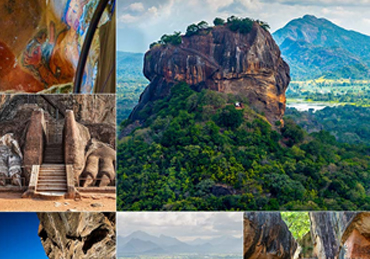
Sigiriya Rock Fortress & City Often considered the “Eighth Wonder of the World”, the ruins of the capital of King Kashyapa (Kassapa), lie on the slopes & summit of a 200 meter high rock. A combination of a palace & a fortress, Sigiriya (Lion Rock), built in 5th century AD, is a UNESCO World Heritage Site. The imposing rock fortress, taking its name from the lion paws carved at the entrance, is an awesome sight. Colorful tapestry-like frescos painted on the rock face, and the terraced summit offering a astounding views of the mist shrouded forests, are sure to overwhelm you. Its delightful grooves, nicks & crevices, conceal cherished pieces of the past while its splendid gardens & cave shrines depict the culture & history of Sri Lanka.
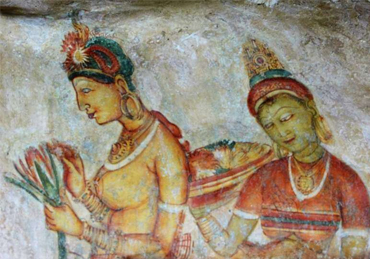
Sigiriya Rock Fortress is popular for its amazing architecture and the skill and genius that went into building it. As it was the residence of the king, there are many entertainment units as well. The Sigiriya Maidens paintings are widely talked about and praised. It is believed that the massive mural once must have held paintings of around 500 maidens, although only twenty-one paintings have survived to this day. The maidens are painted from the waist up with naked torsos. The torsos meet paintings of clouds, giving way to speculation that these paintings are of goddesses. However, some believe that these maidens were King Kasyapa’s ladies.
Village Tour
Village tour gives you a memorable experience in a countryside rural village in Sri Lanka. You will enjoy the sightseeing of paddy fields, bullock cart ride, traditional catamaran ride in a lake, visit to a chena cultivation, traditional cooking demonstration in a rural village house and authentic Sri Lankan lunch during this tour.Village Tour - Elephant Ride

Village tour gives you a memorable experience in a countryside rural village in Sri Lanka. You will enjoy the sightseeing of paddy fields, bullock cart ride, traditional catamaran ride in a lake, visit to a chena cultivation, traditional cooking demonstration in a rural village house and authentic Sri Lankan lunch during this tour.
Habarana

Habarana - is the heart of the cultural triangle of Sri Lanka. Located in the dry zone of Sri Lanka Habarana is the center point from which guests could explore the glorious past and the historical myths of Sri Lanka. Culture tourists as well as wildlife enthusiasts are bound to find this location a haven to escape to. Habarana is closely located to the Minneriya and Kaudulla National Parks which are the transit points to hundreds of Asian elephants and other wildlife during the dry season.
Minneriya National Park

Located in the north central province of Sri Lanka, Minneriya National Park attracts a large number of visitors because of wild elephants gathering on the grass fields. In the dry months from August to October, more than 400 wild elephants gather on the shores of the reservoir. This gathering is the highlight of the National Park and is one the largest in the wild anywhere in the world.The park is also home to two endemic monkeys; the purple-faced Langur and Toque Macaque. The purple-faced Langur and Toque Macaque are some of the most endangered primates in the world. It is entertaining to watch them in their habitat as these lively monkeys always swing on branches and chase each other around the trees. Bird watching is another activity you can indulge in while at the park. The Sri Lankan Hanging Parrot, Grey Hornbill and Jungle Fowl are some of the birds you should try to spot.
Yala National Park
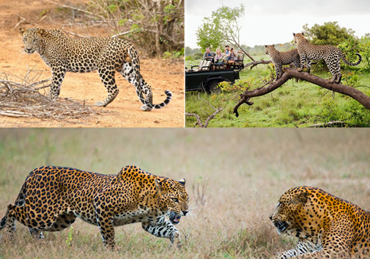
The Yala National Park is the second largest national park in Sri Lanka. Situated in the south- eastern corner of the island. The park has a protected area of nearly 130,000 hectares of land consisting of light forests, scrubs, grasslands, tanks and lagoons.
This leopards’ haunt, is the most popular amongst the tourists visiting the country. An open jeep, a good guide, keen eyes and some luck is all you need to catch the stealthy cat in action, especially during the dry season from February to June. Besides being a leopard hotspot, the park is inhabited by elephants, bears, wild buffaloes, peacocks, monitor lizards and pretty birds.
It is famous for its high density of leopards, perhaps the highest in the world. Yala is also home to a plethora of reptilian species and platoons of crocodiles. Common in Sri Lanka, there is a huge diversity of spectacular birdlife, including migratory species such as the flamingo.Yala is the home to 44 varieties of mammals and 215 bird species. It is also one of the few places in the world where you can still see the severely endangered black-necked stork.
Colombo
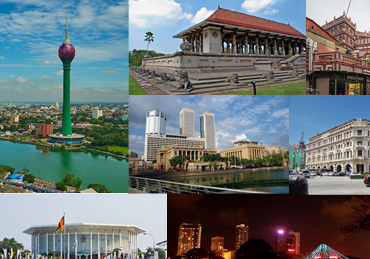
Colombo - is the executive and judicial capital and the largest city of Sri Lanka by population. Colombo metropolitan area has a population of more than 1 million, it is the financial center of the island and a tourist destination. Colombo is a busy and vibrant city with a mixture of modern life, colonial buildings, and monuments.
Due to its large harbor and its strategic position along the East-West sea trade routes, Colombo was known to ancient traders 2,000 years ago. It was made the capital of the island when Sri Lanka was ceded to the British Empire in 1815, and its status as capital was retained when the nation became independent in 1948. In 1978, when administrative functions were moved to Sri Jayawardenepura Kotte, Colombo was designated as the commercial capital of Sri Lanka.
The main city is home to a majority of Sri Lanka's corporate offices, restaurants, and entertainment venues. Famous landmarks in Colombo include Galle Face Green, Viharamahadevi Park, Beira Lake, Colombo Racecourse, Planetarium, University of Colombo, Mount Lavinia beach, Dehiwala Zoological Garden, Nelum Pokuna Theatre, One Galle Face, Gangaramaya Temple, Dutch Museum, Colombo Lotus Tower as well as the National Museum.
Traditional Cultural Dance Show
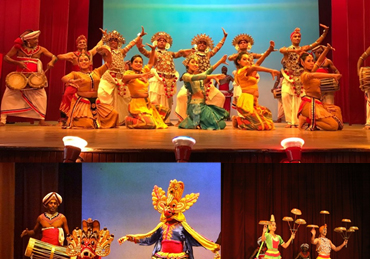
Traditional Cultural Dance Show is a stimulating Sri Lankan Arts, Dance & Cultural Heritage Show that is a must see for any visitor who visits the historic city of Kandy. The show aim to the view of having a cultural dance performance bringing together all Sri Lankan dance types to one platform. It has become a tourist attraction for many people visiting the country and keen on a glimpse of its rich cultural heritage.
Nine Arche Bridge
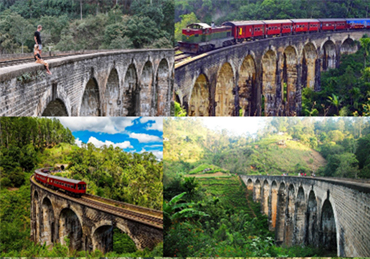
Nine Arche Bridge - also called the Bridge in the Sky, is a viaduct bridge in Sri Lanka. It is located in Demodara, between Ella and Demodara railway stations. It is one of the best examples of colonial-era railway construction in Sri Lanka. The surrounding area has seen a steady increase in tourism due to the bridge's architectural ingenuity and the profuse greenery on the nearby hillsides.
The train ride in the highlands from Kandy to Ella train is named one of the most beautiful train rides in the world. The bridge itself is located between a dense jungle and agricultural setting and is very picturesque and is made out of entirely rocks bricks and cement no metal at all.
Ravana Ella
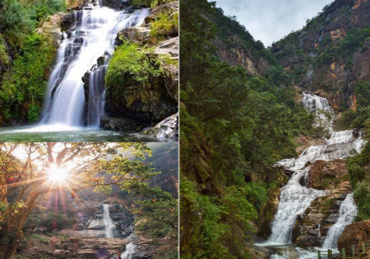
Rawana Ella is measures approximately 25 m (82 ft) in height and cascades from an oval-shaped concave rock outcrop. The falls form part of the Ravana Ella Wildlife Sanctuary and are located 6 km (3.7 mi) away from the local railway station at Ella.
Galle Fort & Light House
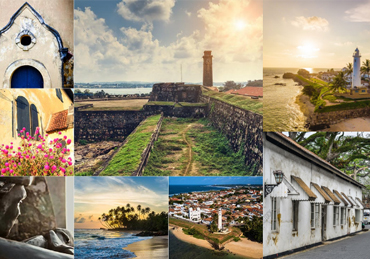
Galle - The fortified city of Galle, located on the southwestern tip of Sri Lanka is a combination of ancient heritage buildings and expansive beaches. Invaded by the Portuguese, colonized by the Dutch, and later ruled by the British. The city reflects an eclectic blend of cultures and civilizations. An important port in past and in the present piece of history a vibrant, Galle has been declared a World Heritage Site by UNESCO.
Major Attractions in Galle Fort & Light House :
Also known as the Dutch Fort, it was initially built by the Portuguese. However, the Dutch invaded won the city, and extensively fortified the bastions of Galle in the 17th century. Towering walls, huge gates, a deep moat and 14 strong citadels depict this striking marvel of European Architecture in South-East Asia. The fort’s 18 meters high lighthouse was built by the British in 1848. The old lighthouse was destroyed by fire in 1934 and was later rebuilt in 1939 and has been operational since.
Turtle Hatchery
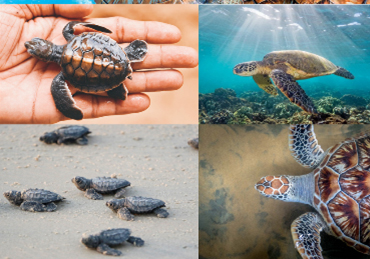
Turtle Hatchery - Situated a few kilometers north of the main Hikkaduwa town lies the Sea Turtle Hatchery and Rescue Centre, a centre with the aim of conserving some of the endangered species of turtles in the world.
It is one of the turtle hatcheries set up to protect turtle eggs till they hatch. Turtle eggs, which would otherwise be eaten, are bought for a few rupees each from local fishermen & re-buried along the beach. Once hatched, the baby turtles are kept in holding tanks. Small tanks contain hundreds of one to three-day old turtles, as well as larger one, including an albino, kept for the collection.
Initially starting as community projects to help protect the biodiversity of the southern coast, these are now a fully-fledged hatchery and rescue centre with dedicated teams that work round the clock to study, care and protect several turtle species.
Anuradhapuraya
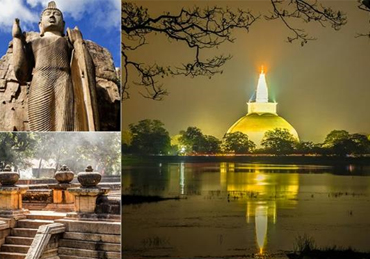
Anuradhapuraya - the capital of Sri Lanka from the 05th Century B.C. to the end of the 10th Century A.D. was the most celebrated of Sri Lankas ancient ruined cities. The city's greatest treasures are its dagobas constructed of bricks and are hemispherical in shape. The most notable of these dagobas are the Ruvanveliseya dating back to the 2nd Century B.C. and is 300 feet in diameter, the Jetawanarama is 370 feet and the Thuparama Dagoba is enshrined with the collarbone of the Buddha.
The city's most renowned relic is the sacred Bo Tree, which is said to have grown from a branch of the tree under which the Buddha gained Enlightenment. It was planted 2250 years ago and is the oldest historically authenticated tree in the world. Anuradhapura is a "World Heritage Site".
Mihintale
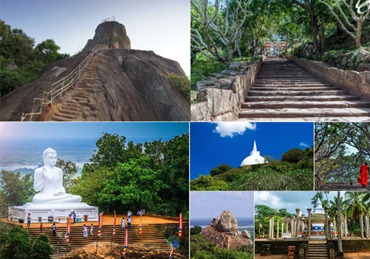
Mihintale is a mountain peak near Anuradhapura in Sri Lanka.In the 3rd century BC, area of Mihintale (mihinthalaya) was a thick jungle area inhibited by wild animals and was a hunting ground reserved for the royals. It is believed by Sri Lankans to be the site of a meeting between the Buddhist monk Mahinda and King Devanampiyatissa which inaugurated the presence of Buddhism in Sri Lanka. It is now a pilgrimage site, and the site of several religious monuments and abandoned structures.
Polonnaruwa
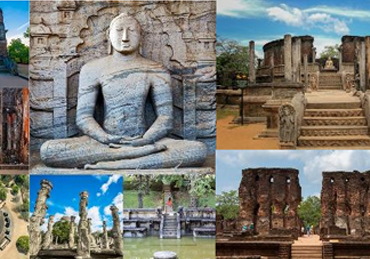
Polonnaruwa - is the second most ancient kingdoms of Sri Lanka and a world heritage site. It comprises, besides the Brahmanic monuments built by the Cholas, the monumental ruins of the fabulous garden-city created by King Parakramabahu I in the 12th century. Here you can see the ruins of the Royal Palace, the Gal Viharaya with 4 four splendid statues of the Buddha in ‘Upright’, ‘Sedentary’ and ‘Recumbent” postures carved out of rock, the Audience Hall, the Lotus Bath. Lankatilake, Tivanka and Thuparama are the most beautiful and largest Image Houses and Tivanka has the best examples of frescoes of the Polonnaruwa period. Rankoth Vehera and Kirivehera are well preserved large stupas. The Vata-da-ge is a unique creation of the Sri Lankan artists.
A dominant feature of the city, is the vast irrigation lake of 5940 acres aptly named “Parakrama Samudraya” or the sea of Parakrama after its royal builder King Parakramabahu depicting an example of the advanced engineering and construction skills prevailent during the ancient times. This gigantic reservoir was built to collect rainwater, which did not permit a drop of water to go waste.
The medieval capital, Polonnaruwa was fortified with inner & outer moats and inner & outer walls. The Parakrama Samudra is on the western side of the city. Another tall wall enclosed the Royal Palace, Audience Hall and other buildings in the inner city.
















